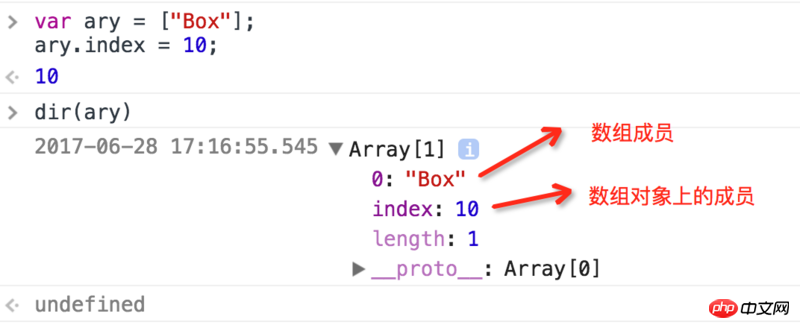My typeof looks at it and it says it is an object, but typeof checks the data and will tell you it is an object.
I used Array.isArray to check again and it returned true.
So I took a look at the explanation of this function on MDN:
https://developer.mozilla.org...
It says the return value is an array.
I took a look at ECMA 5.1 and couldn’t find any description of arrays above
http://ecma-international.org...
So I am also here waiting for the master to answer =. =
----------------- The dividing line for forced explanation ------------------
An instance of an array is also an object, so you can indeed add properties and assign values to it.
But please note that for variables that are not composite types, there is no way to add attributes and assign values to their instances. Because it’s useless even if you do it.
I misremembered, so I thought there was no way to add attribute assignments to numerical instances. . . . .
Although the regular exec return value is an array, it has other attributes. For details, please refer to the documentation. Please read more in Rhinoceros or Height.
var a={0:"Box"};
a.index=10;
a.input="This is a Box! That is a Box!";
var b=["Box"];
b.index=10;
b.input="This is a Box! That is a Box!"
console.log(a,b);
In fact, the most confusing thing here is, why can ["Box"].index=10 be set successfully? Look at the print results first:
To illustrate it more clearly, we expand it and observe its prototype chain. Prototype chain of object a: Prototype chain of array b: As can be seen from the above figure, the array inherits the methods of the Object type from the prototype chain. When ["box"] cannot find the corresponding method in Array(0), it will go down the prototype chain to find the method in Object. So theoretically, the array type can also be considered a type of object type.
My typeof looks at it and it says it is an object, but typeof checks the data and will tell you it is an object.
I used Array.isArray to check again and it returned true.
So I took a look at the explanation of this function on MDN:
https://developer.mozilla.org...
It says the return value is an array.
I took a look at ECMA 5.1 and couldn’t find any description of arrays above
http://ecma-international.org...
So I am also here waiting for the master to answer =. =
----------------- The dividing line for forced explanation ------------------
An instance of an array is also an object, so you can indeed add properties and assign values to it.
But please note that for variables that are not composite types, there is no way to add attributes and assign values to their instances. Because it’s useless even if you do it.
I misremembered, so I thought there was no way to add attribute assignments to numerical instances. . . . .
Although the regular exec return value is an array, it has other attributes. For details, please refer to the documentation. Please read more in Rhinoceros or Height.
Output
aGet, in JavaScript, an array is also an objectMy understanding is the members of the array and the members on the array object.
 ]
]
In fact, the most confusing thing here is, why can ["Box"].index=10 be set successfully?

Look at the print results first:
To illustrate it more clearly, we expand it and observe its prototype chain.


Prototype chain of object a:
Prototype chain of array b:
As can be seen from the above figure, the array inherits the methods of the Object type from the prototype chain.
When ["box"] cannot find the corresponding method in Array(0), it will go down the prototype chain to find the method in Object.
So theoretically, the array type can also be considered a type of object type.
The first question: It’s just an ordinary array
Second question: Grammar error